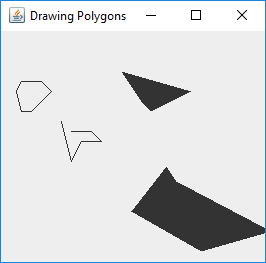

DrawPolygons.java// Fig. 13.28: DrawPolygons.java
// Drawing polygons.
import java.awt.Graphics;
import java.awt.Polygon;
import javax.swing.JPanel;
import javax.swing.JFrame;
class PolygonsJPanel extends JPanel
{
// draw polygons and polylines
@Override
public void paintComponent(Graphics g)
{
super.paintComponent(g);
// draw polygon with Polygon object
int[] xValues = {20, 40, 50, 30, 20, 15};
int[] yValues = {50, 50, 60, 80, 80, 60};
Polygon polygon1 = new Polygon(xValues, yValues, 6);
g.drawPolygon(polygon1);
// draw polylines with two arrays
int[] xValues2 = {70, 90, 100, 80, 70, 65, 60};
int[] yValues2 = {100, 100, 110, 110, 130, 110, 90};
g.drawPolyline(xValues2, yValues2, 7);
// fill polygon with two arrays
int[] xValues3 = {120, 140, 150, 190};
int[] yValues3 = {40, 70, 80, 60};
g.fillPolygon(xValues3, yValues3, 4);
// draw filled polygon with Polygon object
Polygon polygon2 = new Polygon();
polygon2.addPoint(165, 135);
polygon2.addPoint(175, 150);
polygon2.addPoint(270, 200);
polygon2.addPoint(200, 220);
polygon2.addPoint(130, 180);
g.fillPolygon(polygon2);
}
} // end class PolygonsJPanel
public class DrawPolygons
{
// execute application
public static void main(String[] args)
{
// create frame for PolygonsJPanel
JFrame frame = new JFrame("Drawing Polygons");
frame.setDefaultCloseOperation(JFrame.EXIT_ON_CLOSE);
PolygonsJPanel polygonsJPanel = new PolygonsJPanel();
frame.add(polygonsJPanel);
frame.setSize(280, 270);
frame.setVisible(true);
}
} // end class DrawPolygons
Maintained by John Loomis, updated Wed Feb 08 12:27:07 2017